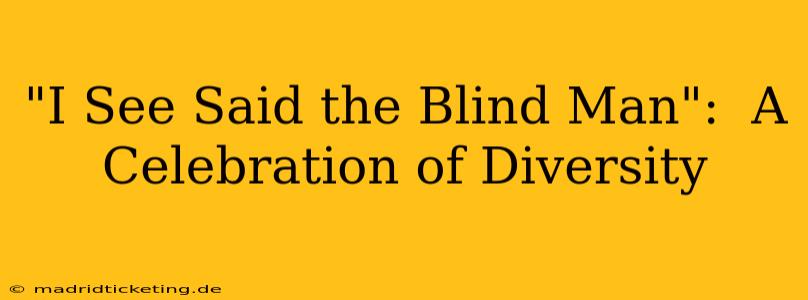The title "I See," Said the Blind Man, while seemingly paradoxical, serves as a powerful metaphor for the multifaceted nature of perception and the importance of celebrating diversity in all its forms. This phrase challenges our assumptions about what it means to "see," expanding the concept beyond the purely visual to encompass a wider range of experiences and perspectives. This article will explore the profound message within this title and delve into how embracing diversity enriches our lives and strengthens our communities.
What Does "I See," Said the Blind Man, Actually Mean?
The beauty of this phrase lies in its ambiguity. It forces us to question our preconceived notions about blindness and vision. The blind man, deprived of sight in the traditional sense, possesses a different kind of "seeing"—a perception honed through other senses, perhaps heightened intuition, or a deeper understanding of the world gained through experience and connection. He sees the essence, the feeling, the truth beyond the visual. This challenges the narrow definition of sight, prompting us to consider the various ways we perceive and interact with the world. The phrase highlights the richness and complexity of human experience, suggesting that "seeing" is not limited to physical vision but extends to empathy, understanding, and intuitive knowledge.
What are the Different Types of Diversity Celebrated in the Phrase?
The phrase "I See," Said the Blind Man, isn't just about visual impairment. It speaks to a broader spectrum of diversity:
-
Sensory Diversity: This encompasses individuals with various sensory experiences, including those with visual, auditory, or other sensory impairments. It recognizes that our experiences of the world are shaped by our sensory capabilities and that different sensory experiences lead to unique perspectives.
-
Cognitive Diversity: This includes individuals with different cognitive abilities, learning styles, and thinking patterns. The blind man's "seeing" might be a result of a different cognitive processing style, showcasing the richness of diverse cognitive landscapes.
-
Cultural Diversity: The phrase can be interpreted through the lens of diverse cultural backgrounds and experiences. Different cultures have unique ways of perceiving and interacting with the world, leading to a tapestry of perspectives that enriches our global understanding.
How Does Embracing Diversity Benefit Society?
Embracing diversity is not simply a matter of political correctness; it's crucial for societal progress and well-being.
-
Innovation and Creativity: Diverse teams bring a wider range of experiences, perspectives, and problem-solving approaches, fostering innovation and creativity. Different ways of "seeing" lead to more comprehensive solutions.
-
Economic Growth: Inclusive economies that value diversity are more robust and resilient. A diverse workforce brings a broader range of skills and talents, contributing to economic growth.
-
Social Cohesion: Celebrating diversity fosters understanding, empathy, and respect among people from different backgrounds, strengthening social cohesion and reducing prejudice.
-
Improved Decision-Making: Diverse groups are less prone to groupthink and make better decisions because they consider a wider range of viewpoints.
How Can We Promote Diversity and Inclusion?
Promoting diversity and inclusion requires conscious effort at both individual and societal levels:
-
Challenge Biases: Actively challenge personal biases and assumptions about people from different backgrounds.
-
Promote Inclusive Language: Use inclusive language that respects the diverse experiences of individuals.
-
Support Inclusive Policies: Advocate for policies and practices that promote diversity and inclusion in workplaces, schools, and communities.
-
Celebrate Differences: Actively celebrate and learn from the diverse experiences of others.
What are some examples of how people with disabilities "see" differently?
People with disabilities, such as blindness, often develop heightened senses and different ways of processing information. A blind person might use echolocation to navigate their environment, or they might rely heavily on their sense of touch to perceive the world. This isn't a "lack" of seeing but a different form of perception, often surpassing the abilities of sighted individuals in specific areas.
What is the importance of inclusive language when discussing disability?
Inclusive language acknowledges the person first, not the disability. Instead of "blind man," it's more respectful to say "man who is blind," emphasizing the individual's humanity and agency. Using person-first language highlights their capabilities and avoids reducing them to their disability.
In conclusion, the phrase "I See," Said the Blind Man, is a powerful reminder of the multifaceted nature of perception and the importance of celebrating diversity in all its forms. By embracing diverse perspectives, we enrich our lives, strengthen our communities, and build a more just and equitable world. The concept extends far beyond the simple meaning of sight and encompasses the richness of sensory, cognitive, and cultural diversity, ultimately highlighting the power of different ways of "seeing."

